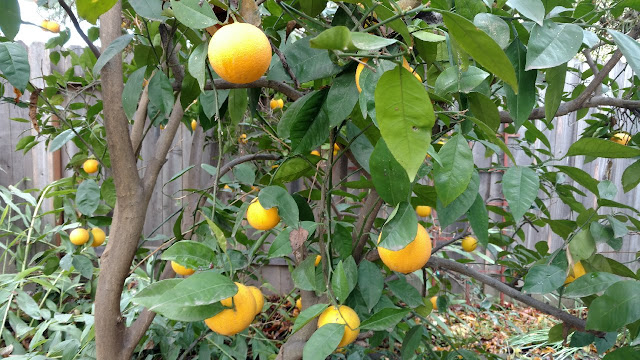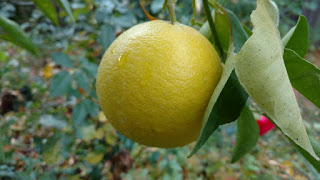
|
|
Are these oranges ready to pick? Not quite yet. (Photos: Debbie Arrington)
|
How to tell when citrus is ready for harvest
December in California brings a vibrant harvest in shades of yellow and orange. It’s the start of citrus season.
Mandarins -- those juicy little easy-peel favorites – start the winter-long procession, followed by navel oranges, blood oranges, kumquats, tangelos, grapefruit and Valencia oranges. Lemons and limes may ripen in winter or later in spring (or even summer or fall). Depending on varieties, fresh backyard citrus can be harvested over six or seven months.
So, when do you pick? The key is knowing when citrus is ripe, which takes some trial and tasting. (With five citrus trees in our yard, we’ve done plenty of both.)
Color alone is not the decider, although it’s a major clue. Navel oranges may be their bright namesake color, but not yet sweet and juicy. Valencia oranges may reach full ripeness while still looking a little green.

|
|
This grapefruit has the right color but it's still weeks away
from harvest.
|
Weather, climate and growing conditions all factor into the citrus calendar. Grapefruit grown in Sacramento can take 12 to 18 months to reach full ripeness, twice as long as the same grapefruit varieties grown in Coachella. The more summer heat, the faster citrus develops.
Once ripe, citrus can hang on the tree for months, too, and still maintain its quality. The best place to store citrus is usually on the tree (except if a heavy frost is in the forecast). It will stay fresh in place until picked.
Another reason to delay picking: Citrus do not ripen off the tree. Once picked, they won’t get sweeter or juicier. Bitter or dry oranges often were just picked too early. In addition, oranges benefit from “a kiss of cold” (overnight temperatures in the 30s) to bring out their natural sugars.
According to citrus experts, ripe citrus looks bright and full colored. But it also feels heavy for its size and firm when squeezed. A fully ripe orange or lemon will slip easily off its stem without tugging. To pick, gently twist and pull at the same time.
The best way to judge ripeness is by tasting. Pick fruit from opposite sides of the tree and sample. Fruit growing on the outside of the tree tends to ripen faster than fruit that grows closer to the trunk. If the trial oranges taste sweet, the tree is ready to pick. If not, wait a week, then sample again.
Oranges are the trickiest to judge. Variety plays a key role. Navel oranges (the popular seedless eating variety) ripen in December and January in Sacramento. They will hold on the tree until March.
Meanwhile, Valencias (the juice orange) may turn color in winter, but aren’t really ready until late February or March. They keep ripening through early June, until the tree finally pushes them off to make room for new fruit.
For more citrus tips:
https://fruitsandnuts.ucdavis.edu
.

